
Antiquities conservator Erik Risser working on Apollo’s drapery in the Conservation Studio at the Getty Villa
A new exhibition opening at the Getty Villa, Apollo from Pompeii: Investigating an Ancient Bronze, marks the completion of an 18-month conservation project that developed in collaboration with the Museo Archeologico Nazionale in Naples.
The exhibition presents the different aspects of a Roman bronze statue of Apollo as an archer—its discovery in Pompeii in 1817 and 1818.
How it was made in antiquity; and how it was reassembled after it had been discovered—but also highlights the variety of approaches that were employed, both in the laboratory and the library, to examine these issues.
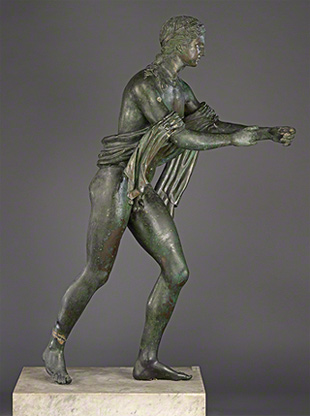
Pre-conservation photo of Apollo as an Archer (Apollo Saettante), Roman, 100 B.C.–before A.D. 79. Soprintendenza Speciale per i Beni Archeologici di Napoli e Pompei—Museo Archeologico Nazionale, Naples
A conservator’s primary goal is to address any factors that are or could potentially be damaging to an object, and even before beginning work on the Apollo, we understood that the drapery ends hanging from its arms needed attention. They were clearly placing a significant strain on the figure, and we later discovered that their combined weight is around 80 pounds—almost as much as the rest of the statue. As the project developed and we studied these drapery ends in detail, we gleaned valuable insights about the restoration of the ancient statue after it had been unearthed.
One of the first methods of analysis was X-radiography of the whole figure. Besides allowing us to see “inside” Apollo, the X-ray images showed that the two bronze drapery ends were much thicker than the rest of the statue—which explained their disproportionate weight.
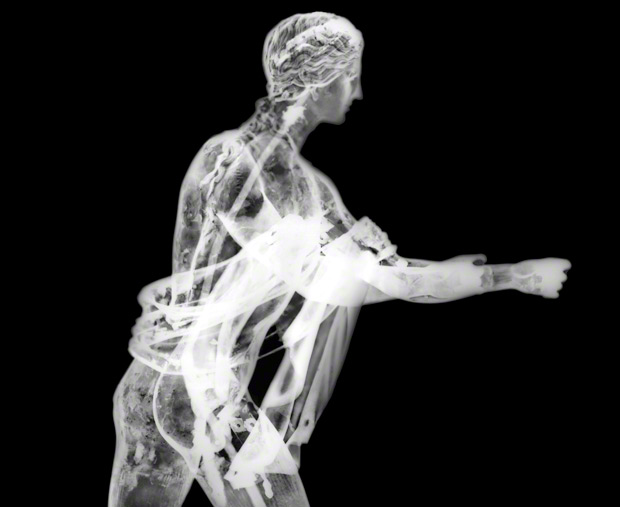
In addition, we could also see very clearly that the drapery ends had been attached to the arms with a series of screws. Investigation of these joins under magnification, combined with ultraviolet (UV) photography (shown below), helped us to identify the extent to which materials such as lead solder and colophony had been used both as reinforcements and to conceal the joins. Having conducted these visual—and non-invasive—studies, we made the decision to remove the two drapery ends for further analysis.
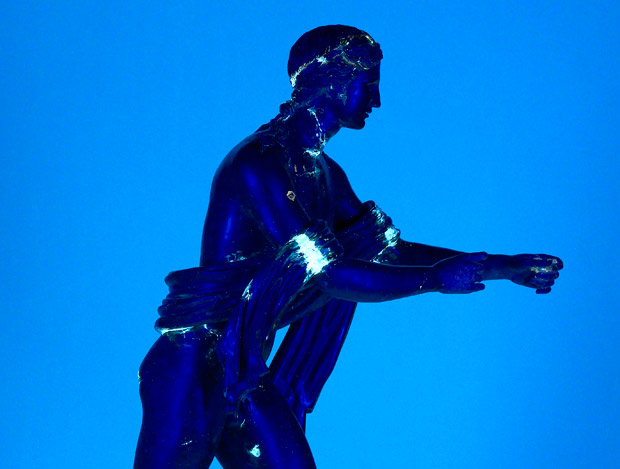
Meanwhile, another feature had given us pause.
In the EARLIEST image of the APOLLO POMPEI (below, left), which dates to 1825, just a few years after the statue was discovered, the drapery ends looked rather different from the bronze parts we were dealing with.
Rather than depicting long heavy forms that terminate with a tassle and a weight, the engraving shows the Apollo with much shorter drapery, fluttering lightly by his side as he strides forward.
The difference could be dismissed as artistic license, but other mid-19th-century images of the statue in books in the collection of the Getty Research Institute (such as the one below, right) show exactly the same features—and likewise, do not match the bronze drapery ends.
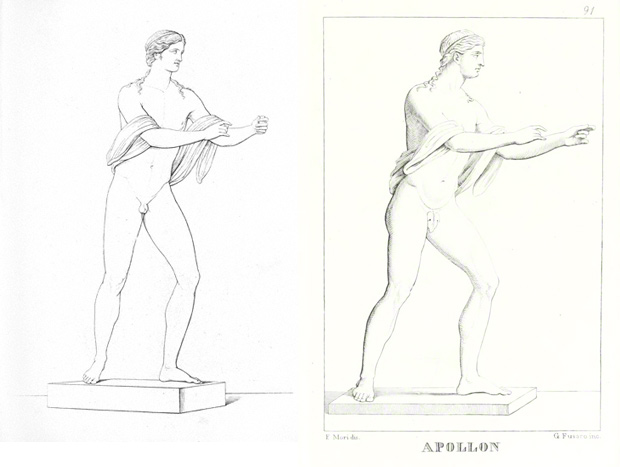
19th-century views of the Apollo. Left: The Restored Statue of Apollo, Engraving in Raffaele Gargiulo, Raccolta de Monumenti più interessanti del Re. Museo Borbonico . . ., Naples, 1825. The Getty Research Institute, 85-B19893. Right: The Restored Statue of Apollo, after F. Mori, engraving in Domenico Monaco, Les monuments du Musée National de Naples, Naples, 1879. The Getty Research Institute, 2573-379
Once we had removed the drapery ends, we encountered another puzzle.
There were holes in the arms, but they did not all correlate with the screws that were used to attach the sections of the bronze drapery. On the right arm, for example, there is a third hole that’s somewhat smaller than the other two.
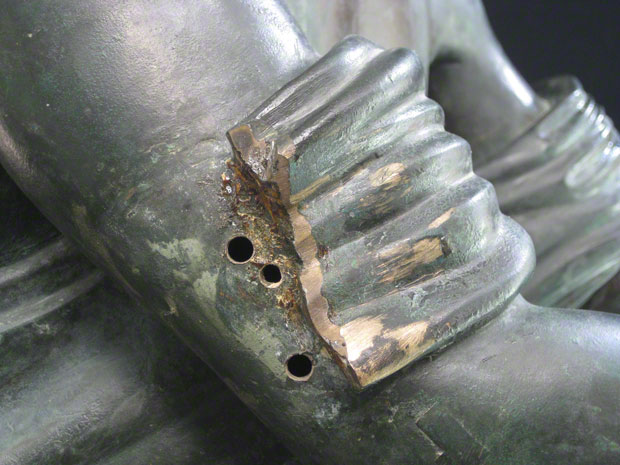
This suggested that there had been two different interventions. The results of metallurgical analysis of samples taken from each of the bronze drapery ends also pointed in this direction. The samples matched one another, but their composition was not only different from the ancient metal alloy, but also from the metal alloy that had been used elsewhere in the restoration and reconstruction of the statue in the early 19th century.
The combination of these diverse analytical methods led to a single conclusion: that the bronze drapery ends were not only NOT ancient, but also NOT part of the statue’s original restoration in the early 19th century.
They were rather part of a second phase of restoration, replacing the lighter-looking parts that we had encountered in the drawings.
Proof came with the assistance of our colleagues in Naples, who had access to the old museum inventories.
In 1844, and again in 1849, it was recorded that the drapery ends were made of plaster.
Evidently, therefore, the ancient fragments had not been recovered, and so the drapery ends had been fabricated in plaster when the statue was first restored.
These were what we saw in the archival drawings.
When were the plaster ends replaced by the bronze parts?
The earliest PHOTOGRAPHS of the Apollo on display in the Gallery of the Bronzes in the Naples Archaeological Museum date to the mid-1860s, and here the statue has the bronze drapery ends.
Bringing together the available evidence, we concluded that the switch must have happened between 1849 and the mid-1860s.
But we haven’t yet encountered any documentation recording the change, so can only speculate as to why.
Perhaps the plaster ends were damaged, or no longer looked effective.
Or there may have been a change in taste or practice at the museum, which demanded the fabrication of bronze repairs.
The questions raised in studying the drapery were critical to our understanding of the statue and the phases of its restoration.
But as is so often the case, the answers we obtained only prompted new lines of inquiry.
One of the most pressing, of course, was how to display the statue once we had removed the bronze drapery ends.
We decided to fabricate replacement parts in epoxy, using the 19th-century archival images to guide us.
These new drapery ends are mechanically attached to the statue using the pre-existing holes in the arms, and can be removed without any risk of damage to the ancient bronze.
Thus, the Apollo that now graces our galleries looks similar to the way it did in Naples after it had first been reassembled.
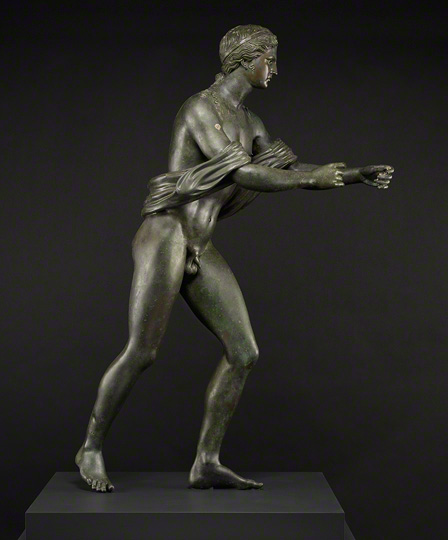
Post-conservation photo of Apollo as an Archer; below, a detail of the drapery

All photographs of the statue of Apollo are courtesy of the Soprintendenza Speciale per i Beni Archeologici di Napoli e Pompei.





No comments:
Post a Comment